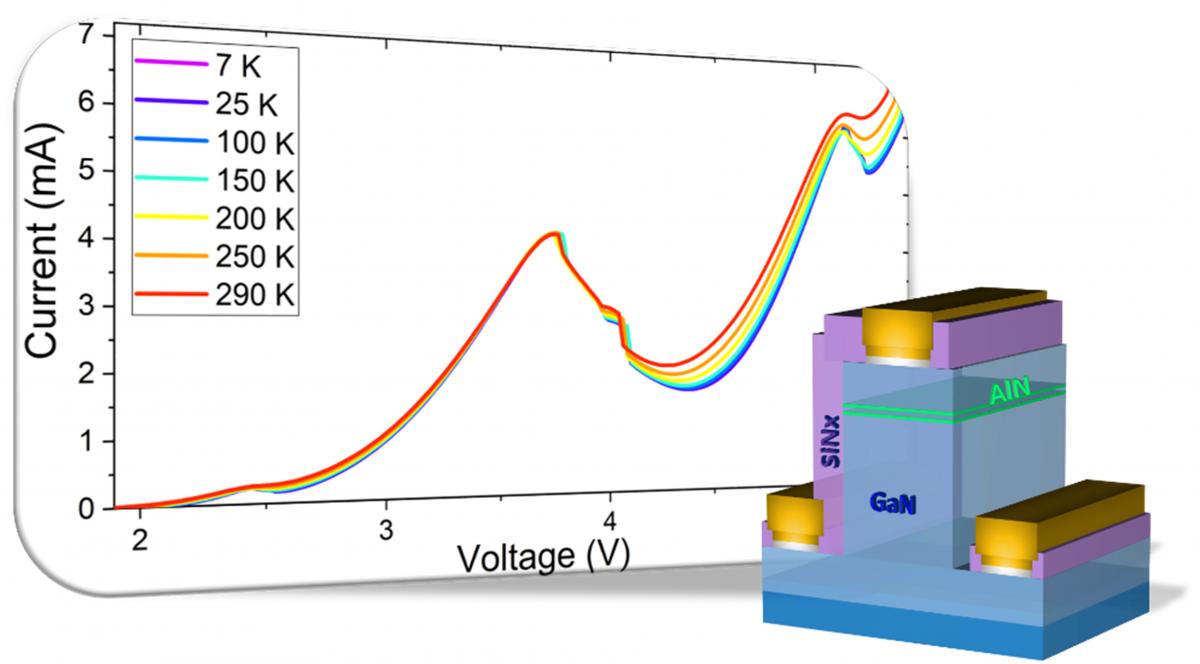News: Microelectronics
18 May 2020
NRL develops GaN-based resonant tunneling diode with beyond-5G performance
Working with colleagues at Ohio State University, Wright State University and industry partners, research physicist David Storm and electrical engineer Tyler Growden of the US Naval Research Laboratory (NRL) have developed a gallium nitride (GaN)-based resonant tunneling diode (RTD) yielding direct measurement of record switching speeds in GaN/AlN RTDs, beyond the anticipated speed of 5G (Growden et al, ‘Superior growth, yield, repeatability, and switching performance in GaN-based resonant tunneling diodes’, Applied Physics Letters (2020), 116, 113501).
“Our work showed that gallium nitride-based RTDs are not inherently slow, as others suggested,” Growden says. “They compare well in both frequency and output power to RTDs of different materials.”
The diodes enable extremely fast transport of electrons to take advantage of the quantum tunnelling phenomenon, where electrons create current by moving through physical barriers due to their simultaneous particle- and wave-like nature.
Grown by plasma-assisted molecular beam epitaxy (PAMBE), Storm and Growden’s design for GaN-based diodes achieved both record current outputs and switching speeds.
Temperature-dependent measurements - combined with non-equilibrium Green's function-based quantum transport simulations - suggest the presence of both three-dimensional (3D) and two-dimensional (2D) emitters, giving rise to three repeatable negative differential resistance (NDR) regions below a bias of +6V. Repeatability measurements consisting of 3000 sweeps resulted in a standard deviation, relative to the mean, of < 0.1%. Also, a study of valley current density versus perimeter-to-area-ratio indicates the presence of a surface leakage current mechanism, which reduces the peak-to-valley current ratio (PVCR). However, a room-temperature PVCR > 2 was observed, which represents a marked improvement over recent reports.
Such perfomance enables applications in the millimeter-wave region and frequencies in terahertz, including in communications, networking, and sensing.

Graphic: Simplified view of the GaN-based resonant tunneling diode developed at NRL’s Electronic Science and Technology Division and its performance characteristics. NRL anticipates this RTD will enable technologies beyond 5G and created a process to deliver manufacturing yield of about 90%. NRL graphic by Tyler Growden.
Unfortunately, because they require sharp interfaces at the atomic level and are very sensitive to many sources of scattering and leakage, achieving a high yield of operational tunneling devices can be difficult, says Storm. “Until now, gallium nitride was difficult to work with from a manufacturing perspective,” he adds. However, the team has developed a repeatable process to increase the diodes’ yield. Sample preparation, uniform growth and a controlled fabrication process at every step were key to the diodes achieving satisfactory results on a chip, say the researchers. Measurements carried out on hundreds of devices, of varying sizes, revealed a yield of about 90%; previous typical yields range around 20%. The high yield was largely “due to our design,” Storm says.
Storm and Growden say that they are committed to continue refining their RTD design to improve the current output without losing power potential.









